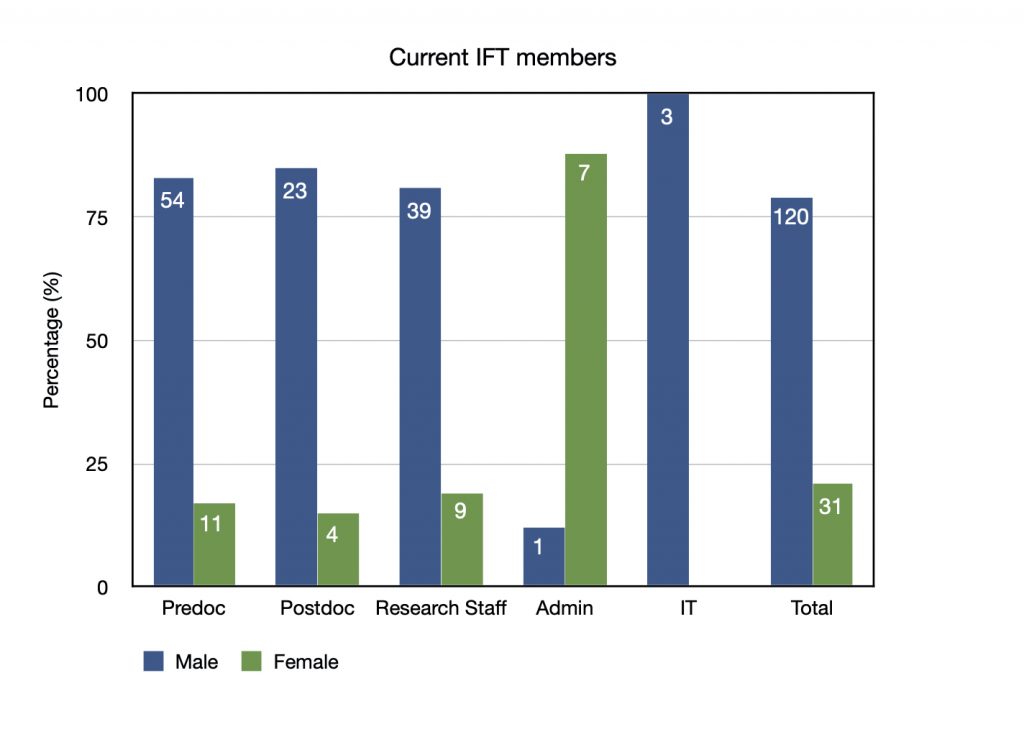The elaboration of the EDI Action Plan of the IFT has included an analysis and diagnosis phase of the current state of play of our institution. Quantitative data has been collected with a view to detect biases in the implementation of procedures, processes and practices, in particular with regard to gender inequalities and gender bias. We present below the statistics gathered regarding gender balance among IFT personnel, governing boards and IFT activities.
A key observation is that within STEM fields, theoretical physics has a particularly severe gender gap problem, starting at the undergraduate level. In 2017, the proportion of female science students at UAM was 53%, but only 26% in Physics. In our Masters in Theoretical Physics it is even lower, 0% in 2020-21, 25% in 2021-22 and 15% in 2022-23. According to the 2020 report of the MyC CSIC committee, only 23% (26,5%) of the pre-doctoral (post-doctoral) researchers in Physics recruited by CSIC in 2019 were women. The report: “Las físicas en cifras: Universidad”, prepared by the group “Women in Physics RSEF”, shows that the situation is particularly worrying in the field of theoretical physics, where women represented only 15% of the total teaching and research staff in this field in Spanish universities during the period 2015-20. The IFT is seriously committed to taking decisive action to address this issue from the earliest stages of education.
Human Resources

IFT research personnel
The figure indicates the percentage and absolute numbers of female/male researchers as of April 2023 grouped per job category: PhD researchers (predoctoral), postdoctoral researchers, staff members, administrative personnel and Information and Technology personnel, as well as the aggregate number. The numbers on top of each bar indicate the absolute numbers, while the percentages are indicated in the y-axis.

Master students in Theoretical Physics at UAM
Gender balance among students enrolled on the Master on Theoretical Physics at UAM in the specialization of Particle Physics and Cosmology, divided by gender and by academic year.
.
Organization

Present composition of the governing boards and committees
The IFT and Severo Ochoa Board is formed by the Director, Deputy Director, the two heads of Department and two representatives of the IFT personnel. The present Organization Chart of the institute can be found here.

Governing boards and committees – past records
The graphics indicate the proportion (and absolute numbers) of female/male researchers occupying the positions of IFT Director, Deputy Director, Head of Department, members of the IFT Board, Scientific Advisory Board and Severo Ochoa Steering Committee since the institute was officially created in 2003 (the data for the IFT Board and heads of department is restricted to the period 2006-2020). For reference, the proportion of female researchers among the permanent staff at IFT by December 2020 is also shown.
Activities at IFT

Severo Ochoa visiting program
The percentage of female/male researchers participating in the Severo Ochoa 2017-2021 visiting program at the IFT is reported, divided in the two categories of Distinguished Professors and Associate Researchers. The numbers on top of each bar indicate the absolute numbers, while the percentages are indicated in the y-axis.

Short term visitors
Gender balance among all short-term visitors at the IFT, showing the trend in the 2016-2020 period.

Seminars.
Gender balance among seminar speakers at the IFT, displaying the trend since 2017-18.

Colloquia.
The gender balance between colloquia speakers is shown in the figure, this is one of the activities where improvement is urgently required.
Previous Data

IFT research personnel
The figure indicates the percentage and absolute numbers of female/male researchers as of December 2020 grouped per job category: PhD researchers (predoctoral), postdoctoral researchers and staff members, as well as the aggregate number. The numbers on top of each bar indicate the absolute numbers, while the percentages are indicated in the y-axis.
